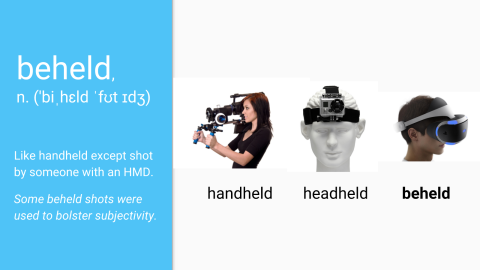beheld
01.23.2016 § Leave a comment
I propose the term “beheld” to refer to the particular type of video which was originally shown in a head mounted display to immerse a person in virtual reality.
In a sense this type of video could be said to be live, as it was live for at least one person: the person in the HMD. It was generated by a computer system which was tracking that person’s movements in real time, transposing them into a virtual environment it knows everything it needs to know about visually, then translating them instantaneously (thousands of times faster than cable news would make it to your TV set!) into moving picture on the screen inside the VR helmet.
But we can experience such video in other contexts after the original viewing by that person who is responsible for producing it. A viewer of an immersive film might wish to share the way she chooses to experience it, the particular path she leads her eyes along through the duration of its envelopment. Or maybe she simply wants to provide some way for folks without HMDs to experience the virtual world, in the form of a traditional 2D moving picture.
I wrote previously about this topic, suggesting the term watchline for an instance of such a recording. What I was seeking beyond this term “watchline” when I began this post was another term which could capture its essence, something adjectival, something that could be the analog for the existing term “handheld”.
Initially, actually, I joked that watchlines were “headheld” footage, since HMD’s are in a sense held by peoples’ heads. But something felt off about this. Something more is going on in subjective recording than what goes in handheld camera, something truer and more intimate. “Headheld” would really be a perfect term for the type of video shot by GoPro’s strapped to people’s heads, merely approximating what they saw themselves out of their own eyes.
But the difference between subjective and headheld recording is more than that superficial few vertical inches of disconnect. Even though that disconnect can get pretty critical when one moves into face-to-face social interaction – the same sad impossibility of eye contact one experiences when teleconferencing and having to look back and forth between the webcam and at the reproduction of the other person’s eyes on the screen below – what I am striving to capture here is more essential even than that.
What I am striving to capture is the difference between the manner in which a person moves her head when her intention is to record material with the camera strapped to it and the manner in which she moves her head when she knows that what she is recording is exactly what she is experiencing, when it was literally “beheld” by that person. Admittedly the aesthetic is rather similar, but I am here precisely to split these types of hairs!
So there’s a technique in cinematography called the point of view shot, but my understanding is that technically “POV” does not necessarily imply first person POV. That is, it can sometimes refer to the general angle taken by a group of people, or even just a less literal more liberal interpretation of an individual’s point of view such as the over the shoulder shot. In other words, the perfectly good word “subjective” should be reserved for actual first person perspective, while POV can best be used to describe shots which are as close to subjective as possible while still technically remaining objective.
Well alright, “subjective” would be the technical term for beheld, then. As in “the director of the film then throws in a subjective shot”. Yes, this would be in the context of a traditional cinematic experience meant to be watched on a screen outside an HMD (or I suppose if you want to complicate things it could be a screen inside a virtual reality), and its energy signature would be distinct from handheld footage and even from headheld footage (even when not dealing with eye contact). That’s just what I’m saying: there’s something special about this type of recording, something special enough that a director would choose to have a cinematographer shoot it by strapping on an HMD and just looking around as a person such as themselves would if in the world of the film.
To be perfectly clear: this aesthetic is relevant even to films which are not themselves immersive. Just as the creators of Surf’s Up had their camera people enter a virtual reality to get truly handheld effects on characters and events that only existed inside computer graphics, the creators with a taste for subjective recording would have their camera people enter virtual reality to get truly human subjective perspectives on the action. If the film was to appear to be live action, it would still need to be based in a computer, that is, photo-realistically rendered, assembled piecemeal out of individually captured real life components, as we don’t yet have the technology for 360 degree camera rigs which record reality intact in three dimensions such that you could walk around inside it; live action immersive recordings are still “nodal”, one could say, limited to experiencing them from the position where the camera was placed.
(In fact, applying subjective recording to an immersive environment could only lead to pain. What I’d imagine this would look like is rather than framing down the direction the producer looked, simply recording the vector of her center of view and dynamically reorienting the experience for viewers of her viewing. But this could only lead to sickness as that viewer felt like they were looking around inside another person’s looking around. It would have to be smoothed out to not be the worst imaginable experience from the standpoint of motion sickness. That said, I’m giving it a shot as we speak.)
For more VR Vocab, check out this video:

Leave a comment